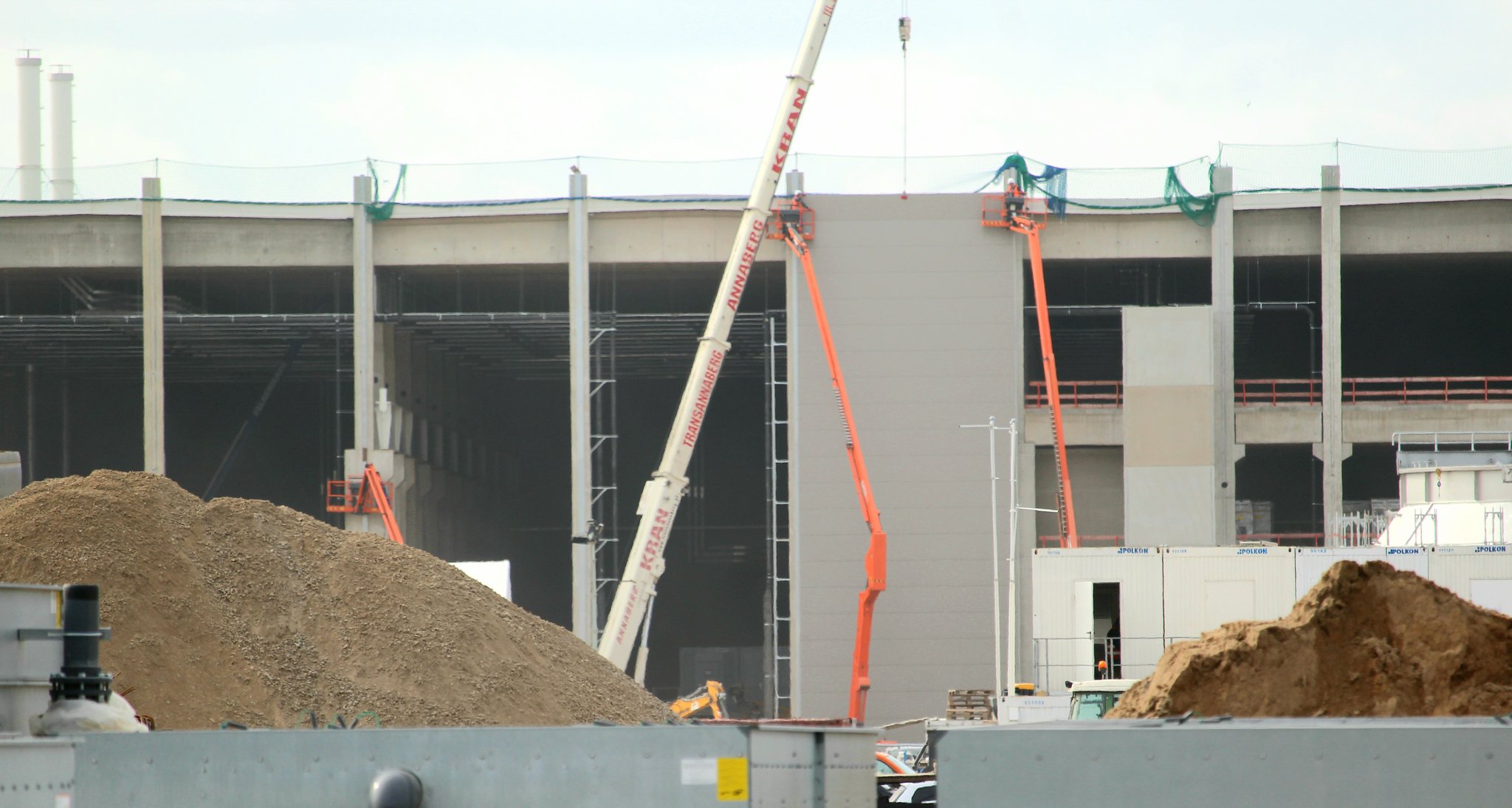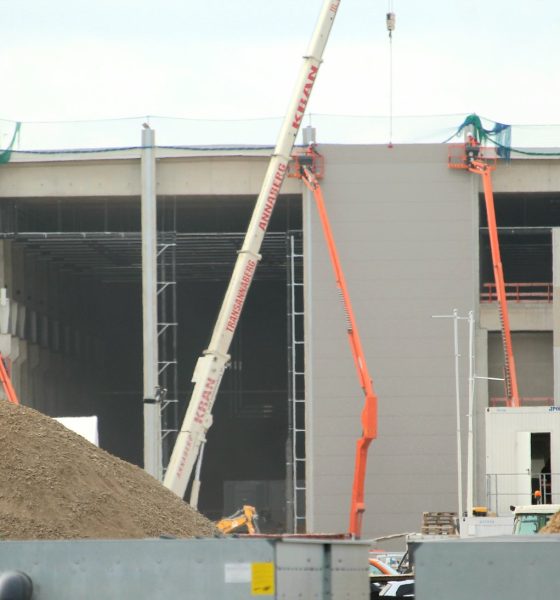Tesla Giga Berlin’s battery factory is beginning to take shape as the first walls of the building were erected on-site earlier today.
In 2019, Tesla announced that it would build a new vehicle production facility in Europe, and it would be located in Brandenburg near Berlin. Labeled as Giga Berlin due to its close vicinity to the City, the company plans to use the factory to supply its vehicles to European customers, where electric cars have been adopted most frequently compared to other markets. The site is set to begin manufacturing vehicles later this year as the main production building where assembly will occur nears completion.
As vehicle production looms at the site, Tesla’s contracted construction crews now turn their attention to the battery manufacturing plant that will produce the new 4680 structural cells that the automaker unveiled in September 2020. After receiving preliminary approval to build the site earlier this year, the battery factory is beginning to take shape, according to new photographs shared by @Gf4Tesla on Twitter.
#GigaBerlin
September 22/2021
++today at the construction site ++.
The last still open area in the casting is now also closed.
The Battery Cell building continues to grow at a rapid pace, first walls are built. pic.twitter.com/q02Q31sCGT— @GF4Tesla ?? ?? (@Gf4Tesla) September 22, 2021
Tesla has not received main approval for the battery factory quite yet, but German authorities only grant preliminary approval to projects that have a substantial chance at being ultimately approved. The project has already gained rumors of financial support, according to a report from Tagesspiegel. The German media outlet reported that Tesla could receive up to €1.135 billion from the Federal Ministry for Economic Affairs and Energy, as the project could be included in the EU’s Important Project of Common European Interest (IPCEI) initiative.
Tesla Giga Berlin 4680 cell production nears as gov’t decides battery factory’s subsidies
Because the plant will be ready to build vehicles before the 4680 battery lines ramp, Tesla will send cells from the Kato Road facility in Northern California to Germany to support the production of the company’s electric vehicles. As of now, the 4680 cells will be included in the initial Model Y builds that will first roll off of production lines at the facility.
Upon completion, CEO Elon Musk expects the facility to be one of the largest battery manufacturing plants in the world. During the 2020 European Battery Conference last November, Musk said:
“I think it will be the largest. It would be capable of over 100 GWh hours per year of production and then possibly going to 200 to 250. I’m pretty confident at that point it would be the largest battery-cell plant in the world.”
To support the current demand for Tesla’s vehicles in Europe, the company has been exporting builds of the Model 3 and Model Y from Giga Shanghai in China to Europe. The export of these units may begin to decrease as Giga Berlin picks up production, which could supply the European market with up to 500,000 vehicles annually in its first year.
Don’t hesitate to contact us with tips! Email us at tips@teslarati.com, or you can email me directly at joey@teslarati.com.

News
Tesla FSD fleet is nearing 7 billion total miles, including 2.5 billion city miles
As can be seen on Tesla’s official FSD webpage, vehicles equipped with the system have now navigated over 6.99 billion miles.

Tesla’s Full Self-Driving (Supervised) fleet is closing in on almost 7 billion total miles driven, as per data posted by the company on its official FSD webpage.
These figures hint at the massive scale of data fueling Tesla’s rapid FSD improvements, which have been quite notable as of late.
FSD mileage milestones
As can be seen on Tesla’s official FSD webpage, vehicles equipped with the system have now navigated over 6.99 billion miles. Tesla owner and avid FSD tester Whole Mars Catalog also shared a screenshot indicating that from the nearly 7 billion miles traveled by the FSD fleet, more than 2.5 billion miles were driven inside cities.
City miles are particularly valuable for complex urban scenarios like unprotected turns, pedestrian interactions, and traffic lights. This is also the difference-maker for FSD, as only complex solutions, such as Waymo’s self-driving taxis, operate similarly on inner-city streets. And even then, incidents such as the San Francisco blackouts have proven challenging for sensor-rich vehicles like Waymos.
Tesla’s data edge
Tesla has a number of advantages in the autonomous vehicle sector, one of which is the size of its fleet and the number of vehicles training FSD on real-world roads. Tesla’s nearly 7 billion FSD miles then allow the company to roll out updates that make its vehicles behave like they are being driven by experienced drivers, even if they are operating on their own.
So notable are Tesla’s improvements to FSD that NVIDIA Director of Robotics Jim Fan, after experiencing FSD v14, noted that the system is the first AI that passes what he described as a “Physical Turing Test.”
“Despite knowing exactly how robot learning works, I still find it magical watching the steering wheel turn by itself. First it feels surreal, next it becomes routine. Then, like the smartphone, taking it away actively hurts. This is how humanity gets rewired and glued to god-like technologies,” Fan wrote in a post on X.
News
Tesla starts showing how FSD will change lives in Europe
Local officials tested the system on narrow country roads and were impressed by FSD’s smooth, human-like driving, with some calling the service a game-changer for everyday life in areas that are far from urban centers.

Tesla has launched Europe’s first public shuttle service using Full Self-Driving (Supervised) in the rural Eifelkreis Bitburg-Prüm region of Germany, demonstrating how the technology can restore independence and mobility for people who struggle with limited transport options.
Local officials tested the system on narrow country roads and were impressed by FSD’s smooth, human-like driving, with some calling the service a game-changer for everyday life in areas that are far from urban centers.
Officials see real impact on rural residents
Arzfeld Mayor Johannes Kuhl and District Administrator Andreas Kruppert personally tested the Tesla shuttle service. This allowed them to see just how well FSD navigated winding lanes and rural roads confidently. Kruppert said, “Autonomous driving sounds like science fiction to many, but we simply see here that it works totally well in rural regions too.” Kuhl, for his part, also noted that FSD “feels like a very experienced driver.”
The pilot complements the area’s “Citizen Bus” program, which provides on-demand rides for elderly residents who can no longer drive themselves. Tesla Europe shared a video of a demonstration of the service, highlighting how FSD gives people their freedom back, even in places where public transport is not as prevalent.
What the Ministry for Economic Affairs and Transport says
Rhineland-Palatinate’s Minister Daniela Schmitt supported the project, praising the collaboration that made this “first of its kind in Europe” possible. As per the ministry, the rural rollout for the service shows FSD’s potential beyond major cities, and it delivers tangible benefits like grocery runs, doctor visits, and social connections for isolated residents.
“Reliable and flexible mobility is especially vital in rural areas. With the launch of a shuttle service using self-driving vehicles (FSD supervised) by Tesla in the Eifelkreis Bitburg-Prüm, an innovative pilot project is now getting underway that complements local community bus services. It is the first project of its kind in Europe.
“The result is a real gain for rural mobility: greater accessibility, more flexibility and tangible benefits for everyday life. A strong signal for innovation, cooperation and future-oriented mobility beyond urban centers,” the ministry wrote in a LinkedIn post.
News
Tesla China quietly posts Robotaxi-related job listing
Tesla China is currently seeking a Low Voltage Electrical Engineer to work on circuit board design for the company’s autonomous vehicles.

Tesla has posted a new job listing in Shanghai explicitly tied to its Robotaxi program, fueling speculation that the company is preparing to launch its dedicated autonomous ride-hailing service in China.
As noted in the listing, Tesla China is currently seeking a Low Voltage Electrical Engineer to work on circuit board design for the company’s autonomous vehicles.
Robotaxi-specific role
The listing, which was shared on social media platform X by industry watcher @tslaming, suggested that Tesla China is looking to fill the role urgently. The job listing itself specifically mentions that the person hired for the role will be working on the Low Voltage Hardware team, which would design the circuit boards that would serve as the nervous system of the Robotaxi.
Key tasks for the role, as indicated in the job listing, include collaboration with PCB layout, firmware, mechanical, program management, and validation teams, among other responsibilities. The role is based in Shanghai.
China Robotaxi launch
China represents a massive potential market for robotaxis, with its dense urban centers and supportive policies in select cities. Tesla has limited permission to roll out FSD in the country, though despite this, its vehicles have been hailed as among the best in the market when it comes to autonomous features. So far, at least, it appears that China supports Tesla’s FSD and Robotaxi rollout.
This was hinted at in November, when Tesla brought the Cybercab to the 8th China International Import Expo (CIIE) in Shanghai, marking the first time that the autonomous two-seater was brought to the Asia-Pacific region. The vehicle, despite not having a release date in China, received a significant amount of interest among the event’s attendees.










